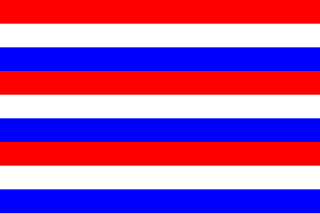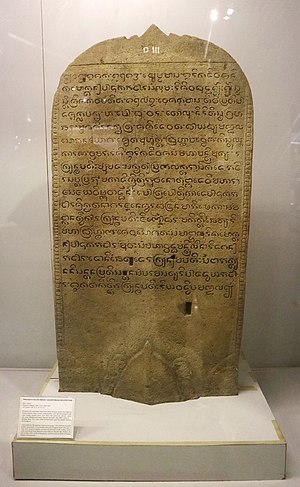
Nusantara is the Indonesian name of Maritime Southeast Asia. It is an Old Javanese term that literally means "outer islands". In Indonesia, it is generally taken to mean the Indonesian Archipelago. Outside of Indonesia, the term has been adopted to refer the Malay Archipelago.

Gajah Mada, also known as Jirnnodhara, was a powerful military leader and mahapatih of the Javanese empire of Majapahit during the 14th century. He is credited in Old Javanese manuscripts, poems, and inscriptions with bringing the empire to its peak of glory.

Singhasari, also known as Tumapel, was a Javanese Hindu-Buddhist kingdom located in east Java between 1222 and 1292. The kingdom succeeded the Kingdom of Kediri as the dominant kingdom in eastern Java. The kingdom's name is cognate to the Singosari district of Malang Regency, located several kilometres north of Malang City.

Hayam Vuruk (1334–1389), also called Rajasanagara, Pa-ta-na-pa-na-wu, or Bhatara Prabhu after 1350, was a Javanese Hindu emperor from the Rajasa dynasty and the 4th emperor of the Majapahit Empire. Together with his prime minister Gajah Mada, he reigned the empire at the time of its greatest power. During his reign, the Hindu epics, the Ramayana and the Mahabharata, became ingrained in the culture and worldview of the Javanese through the wayang kulit. He was preceded by Tribhuwana Wijayatunggadewi, and succeeded by his son-in-law Wikramawardhana.

Malang, historically known as Tumapel, is an inland city in the Indonesian province of East Java. It has a history dating back to the age of the Singhasari Kingdom. It is the second most populous city in the province, with a population of 820,043 at the 2010 Census and 843,810 at the 2020 Census; the official estimate as of mid-2023 was 847,182. The Malang Metropolitan area was home to 3,663,691 inhabitants in 2010, spread across two cities and 22 districts. Malang is the third largest city by economy in East Java, after Surabaya and Kediri, with an estimated 2016 GDP at Rp. 44.30 trillion.

The Nagarakretagama or Nagarakṛtāgama, also known as Desawarnana or Deśavarṇana, is an Old Javanese eulogy to Hayam Wuruk, a Javanese king of the Majapahit Empire. It was written on lontar as a kakawin by Mpu Prapanca in 1365. The Nagarakretagama contains detailed descriptions of the Majapahit Empire during its greatest extent. The poem affirms the importance of Hindu–Buddhism in the Majapahit empire by describing temples and palaces and several ceremonial observances.

Sri Maharajadiraja Sri Kertanegara Wikrama Dharmatunggadewa, Kritanagara, or Sivabuddha, was the last and most important ruler of the Singhasari kingdom of Java, reigning from 1268 to 1292. Under his rule Javanese trade and power developed considerably, reaching the far corners of the Indonesian archipelago.

Tribhuwana Wijayatunggadewi, known in her regnal name Tribhuwannottunggadewi Jayawishnuwardhani, also known as Dyah Gitarja or Gitarja, was a Javanese queen regnant and the third Majapahit monarch, reigning from 1328 to 1350. She also bears the title Bhre Kahuripan. With the help of her prime minister Gajah Mada, she pursued a massive expansion of the empire. Tradition mentioned her as a woman of extraordinary valour, wisdom and intelligence.

The Sunda Kingdom was a Sundanese Hindu kingdom located in the western portion of the island of Java from 669 to around 1579, covering the area of present-day Banten, Jakarta, West Java, and the western part of Central Java. The capital of the Sunda Kingdom moved several times during its history, shifting between the Galuh (Kawali) area in the east and Pakuan Pajajaran in the west.

The Yuan dynasty under Kublai Khan attempted in 1293 to invade Java, an island in modern Indonesia, with 20,000 to 30,000 soldiers. This was intended as a punitive expedition against Kertanegara of Singhasari, who had refused to pay tribute to the Yuan and maimed one of their emissaries. However, in the intervening years between Kertanegara's refusal and the expedition's arrival on Java, Kertanegara had been killed and Singhasari had been usurped by Kediri. Thus, the Yuan expeditionary force was directed to obtain the submission of its successor state, Kediri, instead. After a fierce campaign, Kediri surrendered, but the Yuan forces were betrayed by their erstwhile ally, Majapahit, under Raden Wijaya. In the end, the invasion ended with Yuan failure and strategic victory for the new state, Majapahit.
Balitung was a Javanese king of Mataram. Balitung was his birth name, though like other Javanese kings of this period, he was commonly referred to by his appanage title Rakai Watukura. He reigned from 10 May 898 to c. 911–912. His territories included a wide range of areas in Central Java and East Java.
Gosari inscription or Butulan inscription is an inscription dated 1298 saka located in the Butulan cave, limestone mountain region in Gosari village, Ujungpangkah, Gresik, East Java. Unlike other ancient inscription that usually carved on a large monolith stone, this inscriptions was carved on the cave wall.

The Padang Roco Inscription, in Indonesian Prasasti Padang Roco, is an inscription dated 1286 CE, discovered near the source of Batanghari river, Padangroco temple complex, Nagari Siguntur, Sitiung, Dharmasraya Regency, West Sumatra, Indonesia.

The Wurare Inscription, in Indonesian Prasasti Wurare, is an inscription commemorating the coronation of the statue Mahaksobhya in a place called Wurare. The inscription is written in Sanskrit, dated November 21, 1289 CE. The statue is a tribute and a symbol for Kertanegara, king of Singhasari kingdom, which was considered by his descendants to have achieved the degree of Jina. The inscriptions are written circulary on the pedestal base of the Buddha statue.

Kahuripan was an 11th-century Javanese Hindu-Buddhist kingdom with its capital located around the estuarine of Brantas River valley in East Java. The kingdom was short-lived, only spanning the period between 1019 and 1045, and Airlangga was the only raja of the kingdom, which was built out of the rubble of the Kingdom of Mataram after the Srivijaya invasion. Airlangga later in 1045 abdicated in favour of his two sons and divided the kingdom into Janggala and Panjalu (Kadiri). The kingdom's name derived from Old Javanese term hurip with circumfix ka- -an which means "life" or "livelihood". Later in 14th to 15th century, the former kingdom was recognised as one of Majapahit's 12 provinces.

Gayatri Rajapatni (c.1276—1350) was the queen consort of Majapahit's founder and first king Kertarajasa Jayawardhana, and also the mother of Tribhuwana Wijayatunggadewi, the queen regnant of Majapahit. A devout Buddhist, she was the youngest daughter of Kertanegara, king of Singhasari.

Singhasari temple or Candi Singhasari is a 13th-century syncretic Hindu-Buddhist temple located in Singosari district, Malang Regency, East Java in Indonesia.

The Kingdomship of Bali was a series of Hindu-Buddhist kingdoms that once ruled some parts of the volcanic island of Bali, in Lesser Sunda Islands, Indonesia. With a history of native Balinese kingship spanning from the early 10th to early 20th centuries, Balinese kingdoms demonstrated sophisticated Balinese court culture where native elements of spirit and ancestral reverence combined with Hindu influences—adopted from India through ancient Java intermediary—flourished, enriched and shaped Balinese culture.
Sitopayan II inscription is an inscription written in Proto Batak language and using Old Batak characters. The inscription was found at the Biaro (temple) Si Topayan, in Sitopayan village, Portibi District, North Padang Lawas Regency, North Sumatra Province, Indonesia. The inscription consists of two short lines, written on a horizontal side of the base of a stone idol. F.D.K. Bosch thought that this inscription was made in the 13th century CE, based on the shape and characteristics of the script.
Çri Maharaja Çri Ragajaya was a Balinese king who ruled in the middle of the 12th century CE. The territory of his kingdom most likely covered only the areas north of Lake Batur and East Bali, mainly from Tejakula in Buleleng Regency to Bugbug in Karangasem Regency. The king's name is mentioned on the Tejakula inscription, dated to 1077 Saka. In the inscription, the king appointed the village of Sabhaya to do the jataka for the benefit of a sacred temple, which was named the Bhatara ri Kunjarasana. In return, the villagers were granted various rights for the obligations they had to do.
















